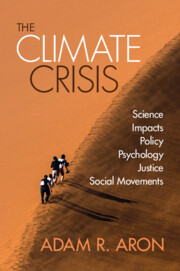Refine search
Actions for selected content:
52 results
Introduction
-
- Book:
- Kant and Environmental Philosophy
- Published online:
- 01 November 2025
- Print publication:
- 20 November 2025, pp 1-12
-
- Chapter
- Export citation
A comparative review of Australia’s fashion and textile industry and global climate perspectives across five decades (1970s–2020s)
-
- Journal:
- Global Sustainability / Volume 8 / 2025
- Published online by Cambridge University Press:
- 08 October 2025, e41
-
- Article
-
- You have access
- Open access
- HTML
- Export citation
1 - Theorizing Regionally Dominant Political and Moral Economies as Causes of Deforestation
- from Part I - Introduction
-
- Book:
- Clearcut
- Published online:
- 03 October 2025
- Print publication:
- 02 October 2025, pp 3-30
-
- Chapter
-
- You have access
- Open access
- HTML
- Export citation
5 - Nobody Is Spared
-
- Book:
- From Crisis to Action
- Published online:
- 15 August 2025
- Print publication:
- 04 September 2025, pp 93-110
-
- Chapter
-
- You have access
- Open access
- HTML
- Export citation
1 - Introduction
- from Part I - Framing Chapters
-
- Book:
- Cities and Environmental Change
- Published online:
- 15 August 2025
- Print publication:
- 28 August 2025, pp 3-16
-
- Chapter
-
- You have access
- Export citation
The Future of (Environmental) History: A Roundtable Discussion
- Part of
-
- Journal:
- Transactions of the Royal Historical Society / Volume 3 / December 2025
- Published online by Cambridge University Press:
- 17 July 2025, pp. 427-447
- Print publication:
- December 2025
-
- Article
-
- You have access
- Open access
- HTML
- Export citation
10 - How Does the State Shape Innovation? How Should It?
-
- Book:
- Innovation Management
- Published online:
- 06 June 2025
- Print publication:
- 10 July 2025, pp 146-159
-
- Chapter
- Export citation
Hollywood Is Burning: Imagery and Polycrisis
- Part of
-
- Journal:
- Public Humanities / Volume 1 / 2025
- Published online by Cambridge University Press:
- 24 June 2025, e107
-
- Article
-
- You have access
- Open access
- HTML
- Export citation
HIDING IN PLAIN SIGHT Why we missed the threat of a new pandemic – and other existential risks
-
- Journal:
- Asia-Pacific Journal / Volume 19 / Issue 14 / July 2021
- Published online by Cambridge University Press:
- 14 March 2025, e2
-
- Article
-
- You have access
- Open access
- Export citation
Epilogue
-
- Book:
- Modern Britain, 1750 to the Present
- Published online:
- 14 January 2025
- Print publication:
- 30 January 2025, pp 526-535
-
- Chapter
- Export citation
12 - New Directions in Australian Art Music: The Curatorial, Creative and Conceptual
- from Part III - Diversities
-
-
- Book:
- The Cambridge Companion to Music in Australia
- Published online:
- 14 November 2024
- Print publication:
- 14 November 2024, pp 188-204
-
- Chapter
- Export citation
Chapter 16 - Parenting and Grandparenting Our Youth in the Climate Crisis
- from Part II - Multidisciplinary Perspectives on Youth Climate Distress
-
-
- Book:
- Climate Change and Youth Mental Health
- Published online:
- 06 June 2024
- Print publication:
- 13 June 2024, pp 309-328
-
- Chapter
- Export citation
Thermal and nutrient stress drove Permian–Triassic shallow marine extinctions
-
- Journal:
- Cambridge Prisms: Extinction / Volume 2 / 2024
- Published online by Cambridge University Press:
- 13 May 2024, e9
-
- Article
-
- You have access
- Open access
- HTML
- Export citation
1 - Introduction
-
- Book:
- Regenerative Strategies
- Published online:
- 28 March 2024
- Print publication:
- 04 April 2024, pp 1-9
-
- Chapter
-
- You have access
- HTML
- Export citation
Towards a public sustainable finance paradigm for the green transition
-
- Journal:
- Finance and Society / Volume 10 / Issue 1 / April 2024
- Published online by Cambridge University Press:
- 25 March 2024, pp. 38-50
-
- Article
-
- You have access
- Open access
- HTML
- Export citation
Climate Crisis and Social Protection - From Worker Protection to Post-growth Transformation?
-
- Journal:
- Social Policy and Society / Volume 22 / Issue 4 / October 2023
- Published online by Cambridge University Press:
- 27 October 2023, pp. 695-714
- Print publication:
- October 2023
-
- Article
- Export citation
If Not Now, Then When? Pathways to Embed Climate Change Within Social Policy
-
- Journal:
- Social Policy and Society / Volume 22 / Issue 4 / October 2023
- Published online by Cambridge University Press:
- 04 October 2023, pp. 675-694
- Print publication:
- October 2023
-
- Article
-
- You have access
- Open access
- HTML
- Export citation
Global Climate Change and UNESCO World Heritage
-
- Journal:
- International Journal of Cultural Property / Volume 29 / Issue 4 / November 2022
- Published online by Cambridge University Press:
- 29 March 2023, pp. 409-432
-
- Article
-
- You have access
- Open access
- HTML
- Export citation
Climate change and the challenge to liberalism
-
- Journal:
- Global Constitutionalism / Volume 12 / Issue 1 / March 2023
- Published online by Cambridge University Press:
- 20 March 2023, pp. 1-10
-
- Article
-
- You have access
- Open access
- HTML
- Export citation

The Climate Crisis
- Science, Impacts, Policy, Psychology, Justice, Social Movements
-
- Published online:
- 15 December 2022
- Print publication:
- 22 December 2022
